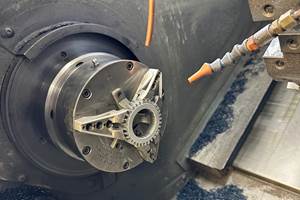Tool Mfr. Commits to Marketing-Free Product Training Seminars
Responding to feedback from its customers, Dapra Corp. changed its seminar model to focus less on marketing, and more on technical training.
Share






Attendees calculate speed and feed with the assistance of Dapra’s applications specialists during a training seminar at the company’s Midwest Technical Center in Rockford, Illinois. (Photo courtesy of Dapra Corp.)
For several years Dapra Corp. has had a technical center in Rockford, Illinois, where, like many other OEMs, the cutting tool manufacturer has conducted training sessions there for its end users and distributors. Recently, however, the company decided to make a change to its training model in response to customer comments about the difficulty of finding and training skilled labor.
Until recently, according to Product Manager Mike Bitner, the two-day seminars had been similar to other vendor-sponsored classes, with ample marketing material included in the training. In fact, it’s been a common complaint from Dapra’s customers that supplier training sessions put more time into product features and benefits than on practical machining training.
“Dapra decided to change that format and dedicate 100 percent of the time to technical milling training,” says Mr. Bitner, who adds that the training provided in these redesigned seminars can be applied to the use of any solid or indexable milling tool from any manufacturer. According to an article Mr. Bitner wrote recently, the topics covered in these seminars now include: choosing speeds and feeds from supplier literature; using speed and feed formulas; climb versus conventional milling; long-reach milling considerations; selection of toolholder style; air versus coolant tooling; coarse-pitch versus fine-pitch tooling; insert grades and geometries; soft versus hard milling techniques; chip thinning (axial and radial); chip formation and tool pressure based on cutting geometry; toolpath selections; and troubleshooting, including wear and failure characteristics.
“The program is really intended for anyone involved in the milling process from programming through setup,” says Mr. Bitner. “Very few of our competitors have field personnel capable of providing on-site training that teaches an end user how to get the most from new cutting tool technology. It is much more common that a manufacturer’s sales engineer is adept enough to conduct a test that earns him the sale, but is not savvy enough to spend the time educating the customer fully on the product. This results in much trial and error on the customer’s part finding out what they can and can’t do with the cutting tool, which can obviously get expensive and frustrating.”
In a program intended to benefit milling machine operators of varying skill levels, the intensive two-day seminar has been reduced to a maximum of 14 attendees at a time, allowing for one-on-one support. “We do not simply lecture for two days on milling techniques and formulas,” Mr. Bitner says. “We engage the class with practical demos on the machine tool, creating teams that are tasked with choosing a grade and geometry for an application, then calculating the proper speeds and feeds for each one as well. We discuss each team's findings as a group before we demonstrate the application, allowing everyone to participate and make safe mistakes.” He adds that the company has received positive feedback from this hands-on approach. Attendees say that the modules on tool selection and calculation of speeds and feeds have been the most beneficial.
Related Content
Lean Approach to Automated Machine Tending Delivers Quicker Paths to Success
Almost any shop can automate at least some of its production, even in low-volume, high-mix applications. The key to getting started is finding the simplest solutions that fit your requirements. It helps to work with an automation partner that understands your needs.
Read MoreShoulder Milling Cuts Racing Part's Cycle Time By Over 50%
Pairing a shoulder mill with a five-axis machine has cut costs and cycle times for one of TTI Machine’s parts, enabling it to support a niche racing community.
Read MoreMedical Shop Performs Lights-Out Production in Five-Axes
Moving to five-axis machining enabled this shop to dramatically reduce setup time and increase lights-out capacity, but success relied on the right combination of workholding and automation.
Read MoreChuck Jaws Achieve 77% Weight Reduction Through 3D Printing
Alpha Precision Group (APG) has developed an innovative workholding design for faster spindle speeds through sinter-based additive manufacturing.
Read MoreRead Next
Machine Shop MBA
Making Chips and ¸ßĹâÂĘÁůşĎ˛Ę are teaming up for a new podcast series called Machine Shop MBA—designed to help manufacturers measure their success against the industry’s best. Through the lens of the Top Shops benchmarking program, the series explores the KPIs that set high-performing shops apart, from machine utilization and first-pass yield to employee engagement and revenue per employee.
Read MoreAMRs Are Moving Into Manufacturing: 4 Considerations for Implementation
AMRs can provide a flexible, easy-to-use automation platform so long as manufacturers choose a suitable task and prepare their facilities.
Read More




















